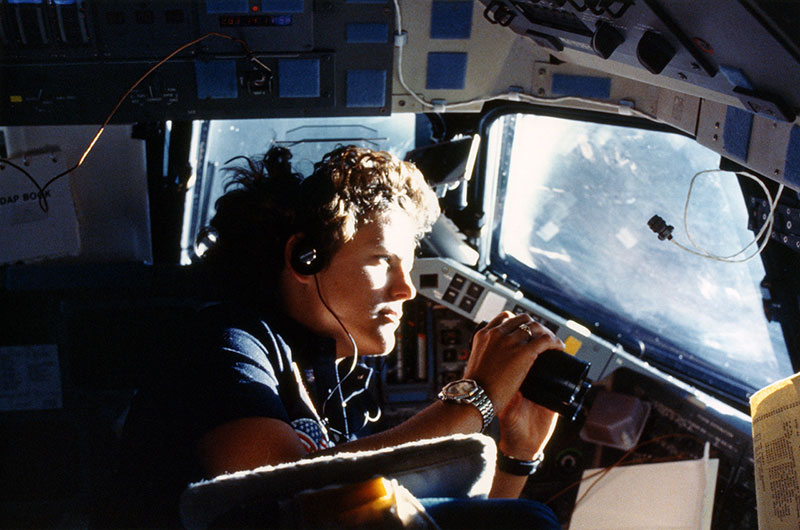 advertisements advertisements
|

|
Astronaut Kathy Sullivan is first woman to dive to Challenger Deep
June 8, 2020 — A former NASA astronaut who was the first American woman to walk in space has become the world's first woman to reach the deepest point on Earth.
Kathy Sullivan on Saturday (June 6) dove to Challenger Deep, the lowest-known location on the planet. She is now the first woman and eighth person to descend the 7 miles (11 kilometers) to the bottom of the crescent-shaped Mariana Trench, located near Guam in the Western Pacific Ocean.
"Challenger Deep — and back!" wrote Sullivan on Facebook after completing the history-making dive. "10,915 m[eters] on our gauges (35,810 ft)."
Sullivan's participation in Caladan Oceanic's "Ring of Fire" expedition comes 36 years after she launched on and performed a spacewalk outside of the space shuttle Challenger in 1984. Both the orbiter and seafloor depression were named after the HMS Challenger, the British Royal Navy survey ship that in 1875 was the first to record the depth of what would later be known as Challenger Deep.
Sullivan's craft on Saturday (Sunday, June 7 in Guam) was the "Limiting Factor," the first commercially-certified full-ocean-depth DSV (deep submergence vehicle). Investor and explorer Victor Vescovo, who underwrote the design and build of the multi-million dollar submersible, served as Sullivan's pilot. The dive marked Vescovo's third visit to Challenger Deep after two record-setting descents in 2019.
"Just back up from Challenger Deep! My co-pilot was Dr. Kathy Sullivan — now the first woman to the bottom of the ocean and a former astronaut," Vescovo wrote on Twitter 12 hours after setting off for the dive. "Big congratulations to her!"
Deployed from the support vessel "Pressure Drop," a former U.S. Navy ship that was specially retrofitted for this expedition, Vescovo and Sullivan explored the eastern pool of Challenger Deep as part of a planned series of scientific dives that will survey the three pools that comprise the slot-shaped depression.
Over the course of as many as eight dives, the Caladan Oceanic team hopes to observe volcanic vents, identify new species of deep sea marine life and map the U.S. Exclusive Economic Zone at the request of the National Oceanic and Atmospheric Administration (NOAA). Among the other team members scheduled to dive is Kelly Walsh, whose father, Don Walsh, was first to reach Challenger Deep with Jacques Piccard on board the Trieste research bathyscaphe 60 years ago.
Sullivan, a retired naval oceanographer, geologist and the former administrator of NOAA, received robotics training before departing for the dive to assist in collecting samples off the ocean floor. The Limiting Factor is outfitted with a Kraft Telerobotics "Raptor" hydraulic manipulator, a claw with a 5-foot (1.5-m) reach.
Prior to joining NASA in 1978 as a member of the first group of U.S. astronauts to include women, Sullivan was on one of the first cruises to utilize a submersible to study the volcanic processes that make the ocean crust.
"My specific aspiration through all of graduate school was to ... be able to actually go down and see the deep-sea floor myself, do the volcanology part of marine geology and geophysics, and get to dive. That's what I was heading toward and aiming everything towards until NASA came along," Sullivan said in a 2007 NASA oral history interview.
In space, orbiting between 220 and 380 miles (350 and 615 km) above Earth, Sullivan helped demonstrate satellite refueling during her historic 3-hour and 29-minute extravehicular activity (EVA, or spacewalk), assisted in the deploy of the Hubble Space Telescope and conducted atmospheric research. In total, she logged 22 days off the planet over the course of her three space shuttle missions between 1984 and 1992.
Following her dive, Sullivan had the opportunity to call the astronauts aboard the International Space Station to share her experience.
"An incredible opportunity and huge step for science!" Caladan Oceanic wrote on Twitter of the sea to space connection.
With Sullivan's dive to Challenger Deep, astronauts have now been to the lowest and highest points on Earth. On May 19, 2009, Scott Parazynski summited Mount Everest, two years after his fifth and final space shuttle mission.
"If you put Everest into the Challenger Deep, its summit would be more than a mile below sea level," Sullivan wrote on her website documenting her expedition.
"What makes ... summiting Everest and reaching the bottom of the Challenger Deep such wildly different challenges is air pressure," she wrote. "From sea level to Everest? About 70 percent less air pressure at the summit than at sea level (1013 millibars to 253). Pressure at the bottom of the Challenger Deep? Over 1,000 times that at sea level (15,750 pounds per square inch, versus 14.7 at sea level)."
Before her record-setting dive, the deepest Sullivan had been was to 8,500 feet (2.5 km) to explore the hydrothermal vents of the East Pacific Rise on the Woods Hole Oceanographic Institution's Alvin submersible in 1996. |
|

Former NASA astronaut Kathy Sullivan is photographed aboard the "Limiting Factor" submersible at the bottom of Challenger Deep, the deepest known point on Earth, June 7, 2020. (Kathy Sullivan)

Former astronaut Kathy Sullivan and explorer Victor Vescovo are seen aboard the "Limiting Factor" deep sea submersible at the bottom of Challenger Deep, Sunday, June 7, 2020. (Kathy Sullivan)

The view at the bottom of Challenger Deep, looking out from the "Limiting Factor" submersible at the automated lander "Skaff" and the "Raptor" hydraulic manipulator, June 7, 2020. (Kathy Sullivan) |

Caladan Oceanic's "Limiting Factor," the first commercially-certified full-ocean-depth deep submergence vehicle. (Caladan Oceanic) |

Kathy Sullivan during her historic spacewalk, the first performed by a U.S. woman, outside of the space shuttle Challenger on Oct. 11, 1984. (NASA) |

STS-41G mission specialist Kathy Sullivan looks out the forward windows on the flight deck of the space shuttle Challenger in October 1984. (NASA) |
|

© 1999-2025 collectSPACE. All rights reserved.
|
|

|

|
